by Bruce Wells | Apr 21, 2025 | This Week in Petroleum History
April 21, 1967 – GM celebrates its 100 Millionth Car –
General Motors celebrated its 100 millionth American-made car (a two-door Chevrolet Caprice). Founded in 1908 by William Durant, the Flint, Michigan, company began as a manufacturer of horse-drawn carriages. After leaving GM, Durant and partner Louis Chevrolet founded the Chevrolet Motor Company in 1911, which became part of GM five years later.
After World War II, GM was the first American corporation to pay more than $1 billion in taxes, according to the Detroit Historical Society, which also notes the company declared bankruptcy in 2009 and emerged less than 40 days later after a federal bailout that saved more than a million jobs. (more…)
by Bruce Wells | Apr 14, 2025 | This Week in Petroleum History
April 14, 1865 – Failed Oilman turns Assassin –
After failing to make his fortune in Pennsylvania oilfields, John Wilkes Booth assassinated President Abraham Lincoln in Washington, D.C. Booth had left his acting career a year earlier to drill an oil well in booming Venango County.
In January 1864, Booth visited Franklin, Pennsylvania, where he leased 3.5 acres on a farm, about one mile south of the village of Franklin and on the east side of the Allegheny River. With several partners, including his friends from the stage, Booth formed the Dramatic Oil Company and raised money to drill a well.

John Wilkes Booth made his first trip to the oil boom town of Franklin, Pennsylvania, in January 1864. He purchased a 3.5-acre lease on the Fuller farm (lower left). Circa 1865 photo of Booth by Alexander Gardner, courtesy Library of Congress.
Although the Dramatic Oil Company’s well found oil and began producing about 25 barrels a day, Booth and his partners wanted more and tried “shooting” the well to increase production. When the well was ruined, the failed oilman left the Pennsylvania oil region for good in July 1864.
Learn more in Dramatic Oil Company.
April 14, 1903 – Patent for Self-Heating Iron fueled by Gasoline
John Lake of Big Prairie, Ohio, received a U.S. patent (No. 725,261) for his gasoline-fueled “Self-Heating Sad Iron.” Lake had served in the 16th Ohio Volunteer Infantry Regiment during the Civil War. The ironing innovation for homes brought prosperity to his Amish community, where he established the Monitor Sad Iron Company on the Pennsylvania Railroad line. His manufacturing company made the petroleum-fueled irons for the next 50 years.
Learn more in Ironing with Gasoline.
April 15, 1857 – First Natural Gas Company incorporated
Two years before the first U.S. oil well in Titusville, Pennsylvania, the Fredonia Gas Light and Water Works Company incorporated in Fredonia, New York, where a well drilled by local machinist and gunsmith William A. Hart supplied natural gas to a mill as early as 1825. Hart found the gas after drilling three wells, according to historian Lois Barris.
“He left a broken drill in one shallow hole and abandoned a second site at a depth of forty feet because of the small volume of gas found,” Barris noted in her “Fredonia Gaslight and Waterworks Company.”
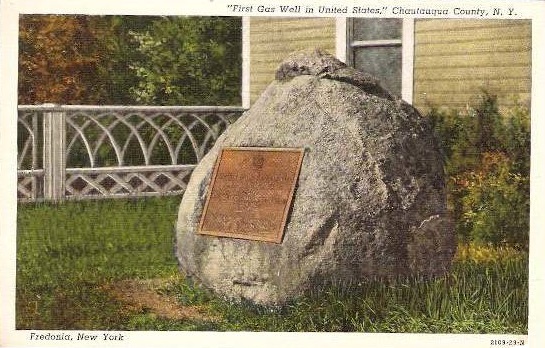
Circa 1950 souvenir postcard of a bronze plaque on a boulder in Fredonia, New York, dedicated in 1925 by the Daughters of the American Revolution.
Hart’s third well produced natural gas from 70 feet beneath a “bubbling gas spring in the bed of a creek,” Barris reported, adding that after constructing a simple gasometer, he “proceeded to pipe and market the first natural gas sold in this country.”
As other communities adopted public lighting burning gas made from coal (manufactured gas street lamps began illuminating Baltimore in 1817), Fredonia Gas Light and Water Works built the first U.S. natural gas pipeline network.

April 15, 1897 – Birth of Oklahoma Oil Industry
With a crowd gathered at the Nellie Johnstone No. 1 well near Bartlesville in Indian Territory, George Keeler’s stepdaughter dropped a “Go Devil” that set off a downhole canister of nitroglycerin. The resulting gusher heralded the start of Oklahoma’s oil and natural gas industry.

A 2017 water gusher demonstration of the Nellie Johnstone No. 1 replica in Discovery One Park, Bartlesville, Oklahoma.
Drilling had begun in January 1897, the same month that Bartlesville incorporated with a population of about 200 people. Four months later, at 1,320 feet, the Nellie Johnstone No.1 well showed its first signs of oil. There had been earlier marginal producers, including a Cherokee Nation 1890 oil well; the Johnstone well revealed the giant Bartlesville-Dewey field.
By the time of statehood in 1907, Oklahoma would lead the world in oil production. An 84-foot derrick in Discovery One Park helps educate visitors about Oklahoma’s petroleum industry. The surrounding land was donated by Nellie Johnstone Cannon, the descendant of a Delaware chief.
Learn more in First Oklahoma Oil Well.
April 16, 1855 – Scientist sees Value in “Rock Oil”
Yale chemist Benjamin Silliman Jr. reported Pennsylvania “Rock Oil” could be distilled into a high-quality illuminating oil. The professor’s “Report on Rock Oil or Petroleum” convinced a businessman George Bissell and a group of New Haven, Connecticut, investors to finance Edwin Drake to drill where Bissell had found oil seeps at a creek in northwestern Pennsylvania.
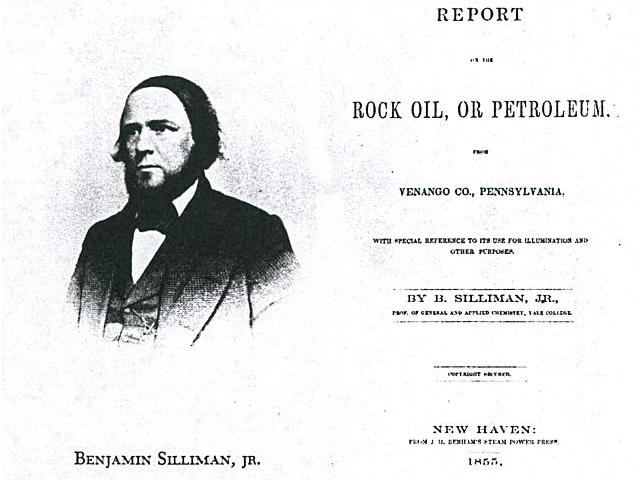
The Yale chemist’s 1855 report about oil’s potential for refining as an illuminant led to America’s first commercial well four years later.
“Gentlemen,” Silliman wrote, “it appears to me that there is much ground for encouragement in the belief that your company have in their possession a raw material from which, by simple and not expensive processes, they may manufacture very valuable products.”
Learn more in George Bissell’s Oil Seeps.
April 16, 1920 – First Arkansas Oil Well
Col. Samuel S. Hunter of the Hunter Oil Company of Shreveport, Louisiana, completed the first oil well in Arkansas. His Hunter No. 1 well had been drilled to 2,100 feet. Natural gas was discovered a few days later by Constantine Oil and Refining Company north of what would become the El Dorado field in Union County.

The Arkansas Museum of Natural Resources is just north of El Dorado.
Although Col. Hunter’s oil well yielded only small quantities, his discovery was followed by a January 1921 gusher — the S.T. Busey well — in the same field. These wells made headlines and launched the Arkansas petroleum industry, according to the Arkansas Museum of Natural Resources. Hunter later sold his original lease of 20,000 acres to the Standard Oil Company of Louisiana for more than $2.2 million.
Learn more in First Arkansas Oil Wells.

April 17, 1861 – Deadly Oil Well Fire in Pennsylvania
The lack of technologies for controlling wells led to a fatal oil well fire at Rouseville, Pennsylvania. Among the 19 people killed was leading citizen Henry Rouse, who subleased the land along Oil Creek. When his well erupted oil from a depth of 320 feet, the good news had attracted most Rouseville residents. “Henry Rouse and the others stood by wondering how to control the phenomenon,” noted the local newspaper. Then the gusher erupted into flames, perhaps ignited by a steam-engine boiler.
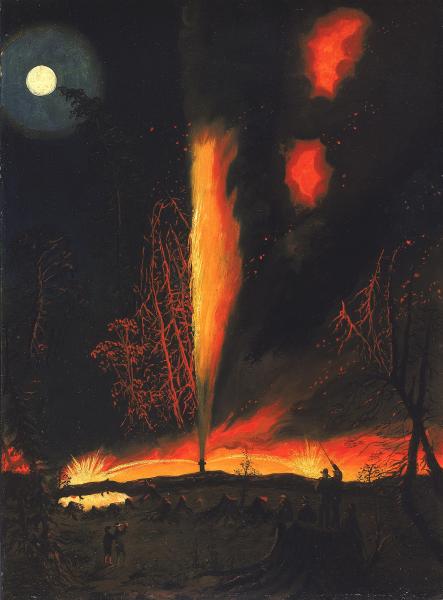
“Burning Oil Well at Night, near Rouseville, Pennsylvania,” a painting by James Hamilton, circa 1861, at the Smithsonian American Art Museum, Washington, D.C.
The oilfield tragedy near Titusville would be overshadowed by the Civil War, but it was immortalized in 1861 by Philadelphia artist James Hamilton’s “Burning Oil Well at Night, near Rouseville, Pennsylvania,” which was added to the Smithsonian American Art Museum collection in 2017.
Learn more in Fatal 1861 Rouseville Oil Well Fire.
April 17, 1919 – North Texas Burkburnett Boom grows
Yet another drilling boom began in Wichita County, Texas, when the Bob Waggoner Well No. 1 well began producing 4,800 barrels of oil a day — extending to the northwest a 1918 oilfield found on the Burkburnett farm of S.L. Fowler. Wichita County had been producing oil since the 1911 discovery of the Electra oilfield.
At Burkburnett, a 2006 historical marker of the Texas Historical Commission notes the 1919 discovery “became known as the Northwest Extension Oilfield, comprised of approximately 27 square miles on the former S. Burk Burnett Wild Horse Ranch.” The marker adds “the area was suddenly thick with oil derricks” thanks to the oilfield discoveries that created the boom town Burkburnett.
April 18, 1939 – Patent for perforating Well Casing
Ira McCullough of Los Angeles patented a multiple bullet-shot casing perforator and mechanical firing system. He explained the object of his oilfield invention was “to provide a device for perforating casing after it has been installed in a well in which projectiles or perforating elements are shot through the casing and into the formation.”
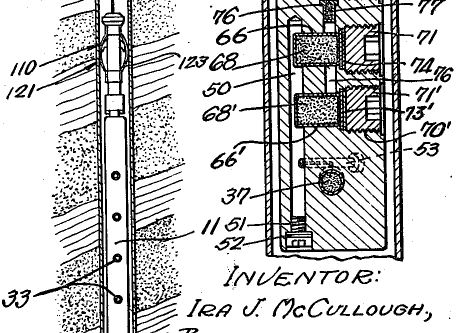
Ira McCullough’s 1937 patent drawing for perforating wells.
The innovation of simultaneous firing from several levels in the borehole greatly enhanced the flow of oil. McCullough’s device included a “disconnectable means” that rendered percussion inoperative until the charges were lowered into the borehole, acting as “a safeguard against accidental or inadvertent operation.”
Another inventor, Henry Mohaupt, in 1951 used anti-tank technology from World War II to improve the concept by using a conically hollowed-out explosive for perforating wells.
Learn more in Downhole Bazooka.
April 19, 1892 – First U.S. Gasoline Powered Automobile
Brothers Charles and Frank Duryea test drove a gasoline-powered automobile they had built in their Springfield, Massachusetts, workshop. Considered the first model to be regularly manufactured for sale in the United States, 13 were produced by the Duryea Motor Wagon Company.
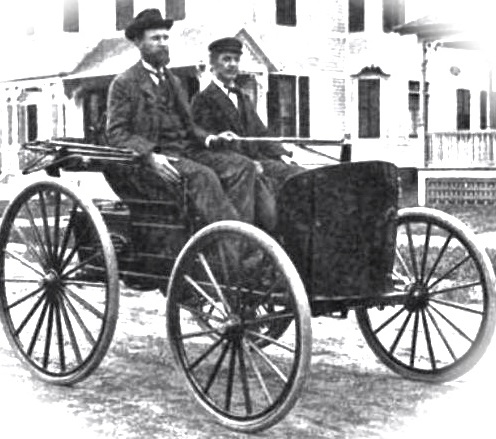
The Duryea brothers (above) built their pioneering autos in Springfield, Massachusetts.
The brothers sold their first Duryea motor wagon in March 1918. Two months later, a motorist driving a Duryea in New York City hit a bicyclist — reportedly America’s first auto traffic accident. By the time of the first U.S. automobile show in November 1900 at Madison Square Garden, of the 4,200 automobiles sold in the United States, gasoline powers less than 1,000.

April 20, 1875 – Improved Well Pumping Technology
Pumping multiple wells with a single steam engine boosted efficiency in early oilfields when Albert Nickerson and Levi Streeter of Venango County, Pennsylvania, patented their “Improvement In Means For Pumping Wells.” The new technology used a system of linked and balanced walking beams to pump oil wells.
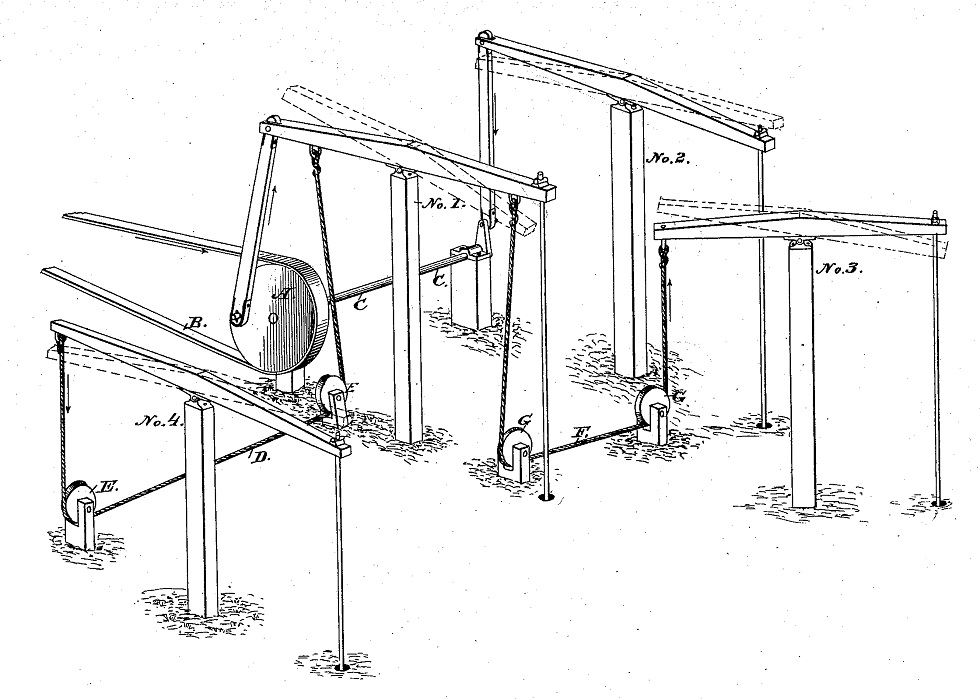
U.S. oilfield technologies advanced in 1875 with an “Improvement In Means For Pumping Wells.”
“By an examination of the drawing it will be seen that the walking-beam to well No. l is lifting or raising fluid from the well. Well No. 3 is also lifting, while at the same time wells 2 and 4 are moving in an opposite direction, or plunging, and vice versa,” the inventors explained. Their system was the forerunner of rod-line (or jerk-line) eccentric wheel systems that operated into the 20th century using iron rods instead of rope and pulleys.
Learn more in All Pumped Up – Oilfield Technology.
April 20, 1892 – Prospector discovers Los Angeles City Oilfield
The giant Los Angeles oilfield was discovered when a struggling prospector, Edward Doheny, and his mining partner Charles Canfield drilled into the tar seeps between Beverly Boulevard and Colton Avenue. Their well produced about 45 barrels of oil a day.
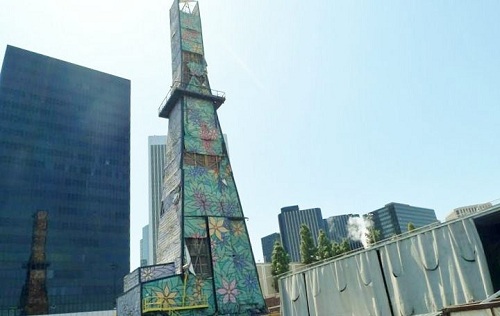
Artfully camouflaged petroleum production continues today in downtown Los Angeles. Edward Doheny discovered the oilfield in 1892. Photo courtesy the Center for Land Use Interpretation, Culver City, California.
Although the first California oil well had been drilled after the Civil War, Doheny’s 1892 discovery near present-day Dodger Stadium launched California’s petroleum industry. In 1897, about 500 Los Angeles City wells pumped more than half of the state’s annual production of 1.2 million barrels of oil. By 1925, California supplied half of all the world’s oil.
Learn more in Discovering Los Angeles Oilfields.
April 20, 2010 – Deepwater Horizon Gulf of Mexico Disaster
At 10 a.m., while completing a well in the Macondo Prospect, 50 miles off the Louisiana coast, the Deepwater Horizon exploded and sank, killing 11 and injuring another 17 workers. An estimated 3.2 million barrels of oil flowed into the Gulf of Mexico after the platform’s 400-ton blowout preventer failed, resulting in the largest accidental marine oil spill in U.S. history.
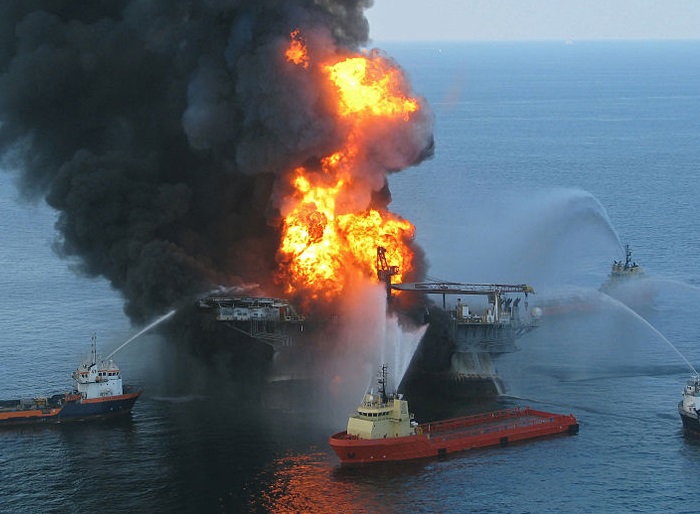
The April 2010 Deepwater Horizon explosion and fire killed 11 and injured 17 workers. USGS Photo.
Six months earlier at another site, the advanced, semi-submersible drilling rig had set a world record for the deepest offshore well (35,050 feet vertical depth in 4,130 feet of water). When the Macondo Prospect well was capped in mid-July, a National Commission on the Deepwater Horizon Oil Spill and Offshore Drilling launched an eight-month investigation. The commission released its final report on January 11, 2011.
_______________________
Recommended Reading: Recommended Reading: Sketches in Crude-Oil (1902); Myth, Legend, Reality: Edwin Laurentine Drake and the Early Oil Industry (2009); The Extraction State, A History of Natural Gas in America (2021); Oil in Oklahoma
(2009); The Extraction State, A History of Natural Gas in America (2021); Oil in Oklahoma (1976); Early Louisiana and Arkansas Oil: A Photographic History, 1901-1946
(1976); Early Louisiana and Arkansas Oil: A Photographic History, 1901-1946 (1982); Cherry Run Valley: Plumer, Pithole, and Oil City, Pennsylvania (2000); Early Texas Oil: A Photographic History, 1866-1936
(1982); Cherry Run Valley: Plumer, Pithole, and Oil City, Pennsylvania (2000); Early Texas Oil: A Photographic History, 1866-1936 (2000); Wireline: A History of the Well Logging and Perforating Business in the Oil Fields
(2000); Wireline: A History of the Well Logging and Perforating Business in the Oil Fields (1990); Dark Side of Fortune: Triumph and Scandal in the Life of Oil Tycoon Edward L. Doheny (2001); Deep Water: The Gulf Oil Disaster and the Future of Offshore Drilling: Report to the President
(1990); Dark Side of Fortune: Triumph and Scandal in the Life of Oil Tycoon Edward L. Doheny (2001); Deep Water: The Gulf Oil Disaster and the Future of Offshore Drilling: Report to the President (2011). Your Amazon purchase benefits the American Oil & Gas Historical Society. As an Amazon Associate, AOGHS earns a commission from qualifying purchases.
(2011). Your Amazon purchase benefits the American Oil & Gas Historical Society. As an Amazon Associate, AOGHS earns a commission from qualifying purchases.
_______________________
The American Oil & Gas Historical Society (AOGHS) preserves U.S. petroleum history. Please become an AOGHS annual supporter and help maintain this energy education website and expand historical research. For more information, contact bawells@aoghs.org. Copyright © 2025 Bruce A. Wells. All rights reserved.
by Bruce Wells | Apr 7, 2025 | This Week in Petroleum History
April 7, 1902 – Spindletop Boom brings The Texas Company –
Joseph “Buckskin Joe” Cullinan and Arnold Schlaet established The Texas Company in Beaumont to transport and refine oil from Spindletop Hill, a giant oilfield discovered in January 1901. The new company constructed a kerosene refinery in Port Arthur — and discovered an oilfield at Sour Lake Springs, where its Fee No. 3 well produced 5,000 barrels of oil a day in 1903.
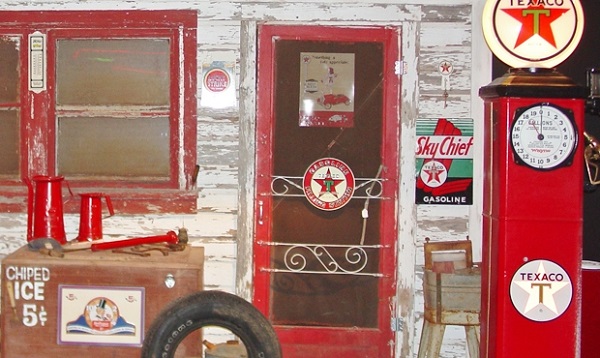
The National Route 66 Museum in Elk City, Oklahoma, preserves the heritage of Texaco, the first petroleum company to market products in all 50 states. Photo by Bruce Wells.
The Texas Company telegraph address at its New York office was “Texaco,” a name soon adopted for its petroleum products. In 1909 a red star with a green capital “T” was trademarked and by 1928 the Texaco brand operated more than 4,000 service stations nationwide. The Texas Company, which officially renamed itself Texaco in 1959, was acquired by Chevron in 2001.
Learn more in Sour Lake produces Texaco.

April 7, 1966 – Cold War Accident boosts Offshore Technology
A robotic technology soon adopted by the offshore petroleum industry was first used to retrieve an atomic bomb. America’s first cable-controlled underwater research vehicle (CURV) attached cables to recover the weapon lost in the Mediterranean Sea.
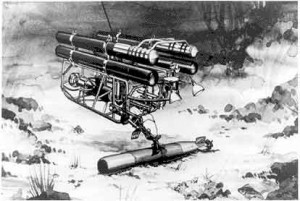
The U.S. Navy in 1966 used its CURV (Cable-Controlled Underwater Recovery Vehicle) to recover a lost nuclear bomb in the Mediterranean.
The 70-kiloton hydrogen bomb, which had been lost when a B-52 crashed off the coast of Spain in January, was safely hoisted from a depth of 2,850 feet.
“It was located and fished up by the most fabulous array of underwater machines ever assembled,” proclaimed Popular Science magazine. During the Cold War, the Navy developed deep-sea technologies that the offshore petroleum industry would adopt and continue to advance.
Learn more in ROV – Swimming Socket Wrench.
April 8, 1929 – Sinclair vs. United States
The Supreme Court unanimously upheld a lower court ruling that Congress had the right to investigate Sinclair Oil founder Harry Sinclair’s personal dealings with Secretary of the Interior Albert Fall regarding the leasing of federal oil reserves. In 1922, Fall had leased land in the Teapot Dome oilfield (Navy Reserve No. 3) to the Mammoth Oil Company, a Sinclair subsidiary. He also leased land in California’s Elk Hills reserve to Edward Doheny, the 1892 discoverer of the Los Angeles Field.
After several trials, proceedings concluded with Doheny being acquitted of conspiracy and Fall convicted of accepting bribes and serving nine months in prison, notes the Federal Judicial Center. He was the first cabinet official to go to prison. Sinclair was acquitted of conspiracy but convicted of contempt of Congress and served six and a half months in prison in 1929.
April 9, 1914 – Ohio Cities Gas Company founded
Beman Dawes and Fletcher Heath organized the Ohio Cities Gas Company in Columbus, Ohio, before building an oil refinery in West Virginia. Ohio Cities Gas acquired Pennsylvania-based Pure Oil Company in 1917 and adopted that name three years later. Pure Oil was founded in Pittsburgh in 1895 by independent oil producers, refiners, and pipeline operators to counter the market dominance of Standard Oil Company.
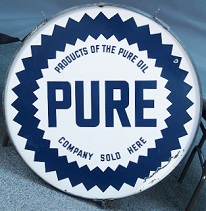
Ohio Cities Gas Company became Pure Oil in 1917.
By producing, refining and selling its products, Pure Oil became the second vertically integrated petroleum company after Standard Oil. Headquartered in a now iconic Chicago skyscraper it built in 1926, the company joined the 100 largest U.S. industrial corporations. It was acquired in 1965 by Union Oil Company of California, now a division of Chevron.
April 9, 1966 – Birthday of Tula’s Golden Driller
A 76-foot statue of an oilfield worker today known as “The Golden Driller” made its debut at the International Petroleum Exposition in Tulsa, Oklahoma. After several refurbishments, the 22-ton statue would contain 2.5 miles of rods and mesh with tons of plaster and concrete — withstanding winds up to 200 mph. A smaller version of Tulsa’s iconic roughneck originally appeared at the 1953 petroleum exposition as a promotion for the Mid-Continent Supply Company of Fort Worth, Texas.
April 10, 1866 – Densmore Brothers patent Railroad Oil Tank Car
James and Amos Densmore of Meadville, Pennsylvania, received a patent for their “Improved Car for Transporting Petroleum,” developed a year earlier in the northwestern Pennsylvania oil regions. Their patent illustrated a simple but sturdy design for securing two re-enforced containers on a typical railroad car.
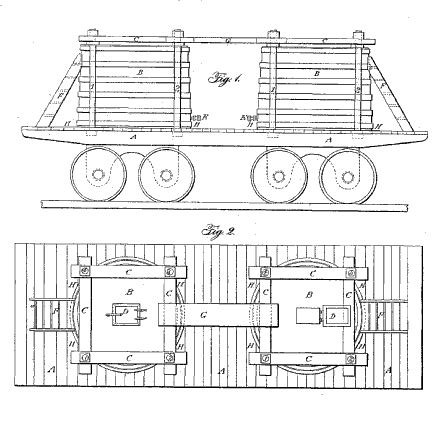
The Densmore dual tank car briefly revolutionized the bulk transportation of oil to market. Hundreds of the twin tank railroad cars were in use by 1866.
Although the Densmore cars were an improvement, they would be replaced by the more practical single, horizontal tank. After leaving the business, Amos Densmore in 1875 invented a new way for arranging “type writing machines” so commonly used letters would not collide — the “Q-W-E-R-T-Y” keyboard. James Densmore’s continued success in oilfields helped finance the start of the Densmore Typewriter Company.
Learn more in Densmore Brothers invent First Oil Tank Car.
April 11, 1957 – Independent Producer William Skelly dies
William Grove Skelly (1878 -1957) died in Tulsa after a long career as an independent producer he began as a 15-year-old tool dresser in early Pennsylvania oilfields. Prior to World War I, he found success in the El Dorado field outside Wichita, Kansas. Skelly incorporated Skelly Oil Company in Tulsa in 1919. In 1923, Skelly organized the first International Petroleum Exposition while serving as president of the Tulsa Chamber of Commerce. Skelly in 1947 helped establish KWGS, Tulsa’s first FM radio station and one of the earliest educational stations in the nation.

April 13, 1974 – Depth Record set in Oklahoma Anadarko Basin
After drilling for 504 days and spending about $7 million, the Bertha Rogers No. 1 well reached a total depth of 31,441 feet (5.95 miles) before being stopped by liquid sulfur. Drilled in Oklahoma’s Anadarko Basin, it held the record of the world’s deepest well for more than a decade.
The GHK Company of Robert Hefner III and partner Lone Star Producing Company believed natural gas reserves resided deep in the Anadarko Basin extending across West-Central Oklahoma and the Texas Panhandle. Their first high-tech drilling attempt began in 1967 and took two years to reach a then record depth of 24,473 feet.
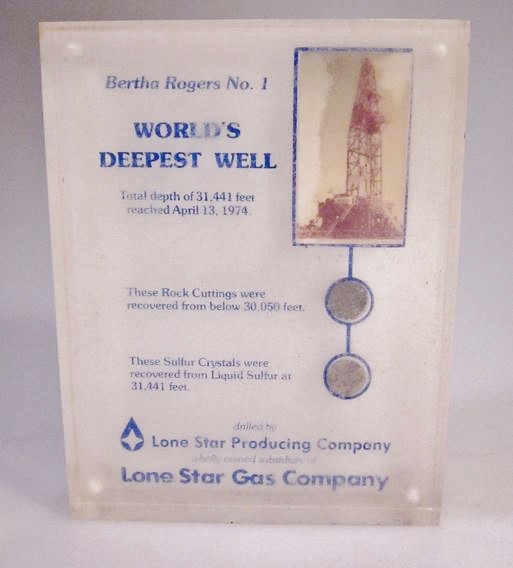
A 1974 souvenir plaque of the Bertha Rogers No. 1 well, which reached almost six miles deep in Oklahoma’s Anadarko Basin.
The 1969 well found plenty of natural gas, according to historian Robert Dorman, but because of federal price controls, “the sale of the gas could not cover the high cost of drilling so deeply – $6.5 million, as opposed to a few hundred thousand dollars for a conventional well.”
The drilling of the Bertha Rogers well began in November 1972 and averaged about 60 feet per day. By April 1974, bottom-hole pressure reached almost 25,000 pounds per square inch with a temperature of 475 degrees. The well’s 1.5 million pounds of casing was the heaviest ever handled by a drilling rig, and it took eight hours for cuttings to reach the surface.
Learn more in Anadarko Basin in Depth.
_______________________
Recommended Reading: The Texaco Story: The First Fifty Years, 1902-1952 (2012); Mapping the Deep: The Extraordinary Story of Ocean Science
(2012); Mapping the Deep: The Extraordinary Story of Ocean Science (2002); Diving & ROV: Commercial Diving offshore (2021); The American Railroad Freight Car (1995); Story of the Typewriter, 1873-1923 (2019); Tulsa Where the Streets Were Paved With Gold – Images of America
(2002); Diving & ROV: Commercial Diving offshore (2021); The American Railroad Freight Car (1995); Story of the Typewriter, 1873-1923 (2019); Tulsa Where the Streets Were Paved With Gold – Images of America (2000); Oil in Oklahoma
(2000); Oil in Oklahoma (1976); History Of Oil Well Drilling
(1976); History Of Oil Well Drilling (2007). Your Amazon purchase benefits the American Oil & Gas Historical Society. As an Amazon Associate, AOGHS earns a commission from qualifying purchases.
(2007). Your Amazon purchase benefits the American Oil & Gas Historical Society. As an Amazon Associate, AOGHS earns a commission from qualifying purchases.
_______________________
The American Oil & Gas Historical Society (AOGHS) preserves U.S. petroleum history. Please become an AOGHS annual supporter and help maintain this energy education website and expand historical research. For more information, contact bawells@aoghs.org. Copyright © 2025 Bruce A. Wells. All rights reserved.
by Bruce Wells | Mar 31, 2025 | This Week in Petroleum History
March 31, 1919 – Oklahoma’s Other First Oil Well –
The Cherokee-Warren Oil and Gas Company incorporated — taking over the remaining assets of the exploration venture that drilled Oklahoma’s “other first oil well” in Indian Territory. That well, drilled in 1889 but abandoned by the United States Oil and Gas Company, was on a 100,000-acre lease in the Cherokee Nation.
Edward Byrd, a Cherokee by marriage, had found oil seeps southwest of Chelsea in 1882. Two years later the Cherokee Nation authorized his United States Oil and Gas Company, “for the purpose of finding petroleum, or rock oil, and thus increasing the revenue of the Cherokee Nation.”
Learn more in Another First Oklahoma Oil Well.
April 1, 1911 – First Gusher of “Pump Jack Capital of Texas”
South of the Red River border with Oklahoma, near Electra, Texas, the Clayco Oil & Pipe Line Company’s Clayco No. 1 well launched an oil boom that would last decades. “As news of the gusher spread through town, people thought it was an April Fools joke and didn’t take it seriously until they saw for themselves the plume of black oil spewing high into the sky,” noted a local historian. (more…)
by Bruce Wells | Mar 24, 2025 | This Week in Petroleum History
March 24, 1989 – Exxon Valdez hits Bligh Reef –
After almost 12 years of routine passages by oil tankers through Prince William Sound, Alaska, supertanker Exxon Valdez ran aground on Bligh Reef, resulting in an oil spill affecting 1,300 miles of shoreline. Vessels carrying North Slope oil had safely passed through the sound more than 8,700 times.
Eight of Exxon Valdez’s 11 tanks were punctured and an estimated 260,000 barrels of oil spilled, affecting hundreds of miles of coastline. Investigators later found that an error in navigation by the third mate, possibly due to fatigue or excessive workload, had caused the accident.

Shown being towed away from Bligh Reef, the Exxon Valdez had been outside shipping lanes when it ran aground in March 1989. Photo courtesy Erik Hill, Anchorage Daily News.
When the 987-foot tanker hit the reef that night, “the system designed to carry two million barrels of North Slope oil to West Coast and Gulf Coast markets daily had worked perhaps too well,” noted the Alaska Oil Spill Commission. “At least partly because of the success of the Valdez tanker trade, a general complacency had come to permeate the operation and oversight of the entire system.”
Learn more in Exxon Valdez Oil Spill.
March 26, 1930 – “Wild Mary Sudik” makes Headlines
What would become one of Oklahoma’s most famous wells struck a high-pressure formation about 6,500 feet beneath Oklahoma City and oil erupted skyward. The Indian Territory Illuminating Oil Company’s Mary Sudik No. 1 flowed for 11 days before being brought under control. It produced about 20,000 barrels of oil and 200 million cubic feet of natural gas daily, becoming a worldwide sensation.

Highly pressured natural gas from the Wilcox formation proved difficult to control in the prolific Oklahoma City oilfield. Within a week of a 1930 gusher, Hollywood newsreels of it appeared in theaters across America. Photo courtesy Oklahoma History Center.
Efforts to control the well in Oklahoma City’s prolific oilfield (discovered in 1928) were featured on movie newsreels and national radio broadcasts. It was later learned that after drilling more than a mile deep, the exhausted crew did not realize the Wilcox Sand oil formation was permeated with highly pressurized natural gas.
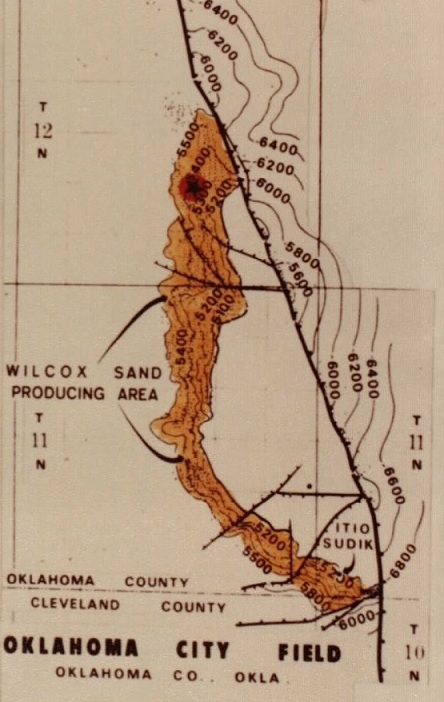
Map of the Wilcox sands formation of the Oklahoma City oilfield in the 1940s.
Although the first ram-type blowout preventer (BOP) had been patented in 1926, deep oil and natural gas fields would take time to tame.
Learn more in “Wild Mary Sudik.”

March 27, 1855 – Canadian Chemist trademarks Kerosene
Canadian physician and chemist Abraham Gesner (1797-1864) patented a process to distill coal into kerosene. “I have invented and discovered a new and useful manufacture or composition of matter, being a new liquid hydrocarbon, which I denominate Kerosene,” he proclaimed. Because his new illuminating fluid was extracted from coal, consumers called it “coal oil” as often as kerosene.
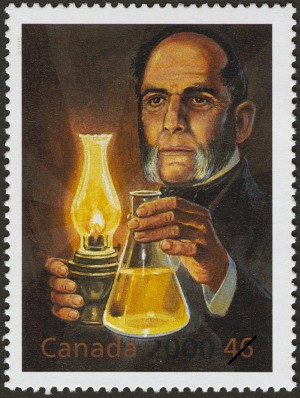
On March 17, 2000, Canada issued one million commemorative stamps featuring kerosene inventor Abraham Gesner.
Gesner, considered the father of the Canadian petroleum industry, in 1842 established Canada’s first natural history museum, the New Brunswick Museum, which today houses one of Canada’s oldest geological collections. America’s petroleum industry began when it was learned oil could be distilled into a lamp fuel.
Learn more in Camphene to Kerosene Lamps.
March 27, 1975 – First Pipe laid for Trans-Alaskan Pipeline
With the laying of the first section of pipe in Alaska, construction began on the largest private construction project in American history at the time. Recognized as a landmark of engineering, the 800-mile Trans-Alaska Pipeline system, including pumping stations and the Valdez Marine Terminal, would cost $8 billion by the time it was completed in 1977.
Learn more in Trans-Alaska Pipeline History.
March 27, 1999 – Offshore Platform Rocket Launch Test
The Ocean Odyssey, a converted semi-submersible drilling platform, launched a Russian rocket that placed a demonstration satellite into geostationary orbit.
The Zenit-3SL rocket, fueled by liquid oxygen and kerosene rocket fuel, was part of Sea Launch, a Boeing-led consortium of companies from the United States, Russia, Ukraine, and Norway. The platform had once been used by Atlantic Richfield Company (ARCO) for North Sea exploration.
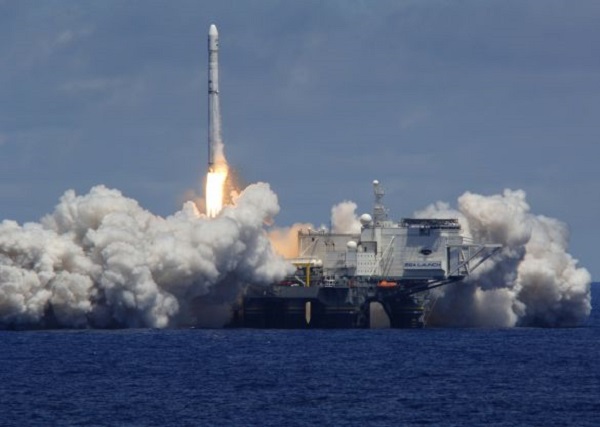
With an orbital test on March 27, 1999, the Ocean Odyssey, a converted semi-submersible drilling platform, became the world’s first floating equatorial launch pad. Photo courtesy Sea Launch.
“The Sea Launch rocket successfully completed its maiden flight today,” Boeing announced. “The event, which placed a demonstration payload into geostationary transfer orbit, marked the first commercial launch from a floating platform at sea.”
The Sea Launch consortium provided orbital launch services until 2014, when Russia annexed the Crimean Peninsula of Ukraine.
Learn more in Offshore Rocket Launcher.

March 28, 1886 – Natural Gas Boom begins in Indiana
Petroleum exploration companies converged on Portland, Indiana, after the Eureka Gas and Oil Company discovered a natural gas field after drilling just 700 feet deep. The well began producing two months after a spectacular natural gas well about 100 miles to the northeast — the “Great Karg Well” of Findlay, Ohio.

According to industrialist Andrew Carnegie, natural gas daily replaced 10,000 tons of coal for making steel.
Portland foundry owner Henry Sees had followed the news from Findlay. He persuaded local investors to drill for Indiana natural gas. In western Pennsylvania, reserves found near Pittsburg had encouraged industrialists there to replace their coal-fired steel and glass foundries with the first large-scale industrial use of natural gas.
Indiana would become the world’s largest natural gas producer, thanks to its Trenton limestone stretching more than 5,100 square miles across 17 counties. Within three years, more than 200 companies were drilling, distributing, and selling natural gas.
Learn more in Indiana Natural Gas Boom.
March 28, 1905 – Oil Discovered in North Louisiana
A small oil discovery in Caddo Parish launched a drilling boom in northern Louisiana and brought economic prosperity to Oil City. The Offenhauser No. 1 well was completed at a depth of 1,556 feet, but yielded just five barrels of oil a day and was abandoned. Far more productive wells quickly followed as the Caddo-Pine Island oilfield 20 miles northwest of Shreveport expanded into 80,000 acres.

The Shreveport Chamber of Commerce in 1955 dedicated a 40-foot monument commemorating the 50th anniversary of oil in Caddo Parish. Photo by Bruce Wells.
“This part of Louisiana, of course, was built on the oil and gas industry, and those visitors interested in the technical aspects of oilfield work will find the museum particularly appealing,” notes the Louisiana State Oil and Gas Museum (formerly the Caddo-Pine Island Oil and Historical Museum). More oilfield history can be found in Shreveport, where natural gas was discovered in 1870 — thanks to an ice plant’s water well. To discourage natural gas flaring, Louisiana passed its first conservation law in 1906.
Learn more in Louisiana Oil City Museum.
March 29, 1819 – Birthday of Father of the Petroleum Industry
Edwin Laurentine Drake (1819-1880) was born in Greenville, New York. Forty years later, he used a steam-powered cable-tool rig to drill the first commercial U.S. oil well at Titusville, Pennsylvania. The former railroad conductor overcame many financial and technical obstacles to make “Drake’s Folly” a milestone in U.S. petroleum history.
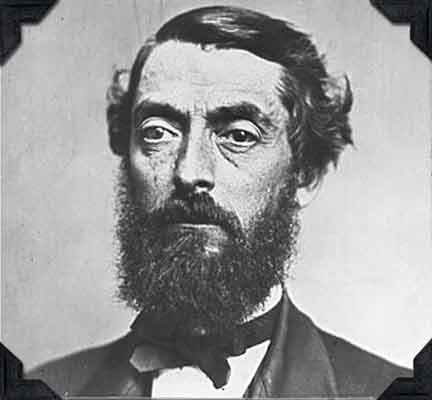
Edwin L. Drake (1819-1880) invented a method of driving a pipe down to protect the integrity of the first U.S. oil well. Photo courtesy Drake Well Museum.
Drake pioneered using iron casing to isolate his well from nearby Oil Creek. “In order to overcome the hurdles before him, he invented a ‘drive pipe’ or ‘conductor,’ an invention he unfortunately did not patent,” noted historian Urja Davé in 2008. “Mr. Drake conceived the idea of driving a pipe down to the rock through which to start the drill.”
Determined to find oil for refining into kerosene, Drake drilled near natural seeps and found oil on August 27, 1859, at a depth of 69.5 feet at a site today on the grounds of the Drake Well Museum.
Learn more in Edwin Drake and his Oil Well.

March 29, 1938 – Magnolia Oilfield found in Arkansas
“Kerlyn Wildcat Strike In Southern Arkansas is Sensation of the Oil Country,” proclaimed the local newspaper when a well drilled by Kerlyn Oil Company revealed the 100-million-barrel Magnolia oilfield, adding to the 1920s giant oilfield discoveries at El Dorado and Smackover.
Drilling on the Barnett No. 1 well had been suspended because of a lack of money, but geologist and company Vice President Dean McGee urged drilling deeper. He was rewarded with a giant oilfield discovery at the depth of 7,650 feet. McGee later would become an industry pioneer in offshore exploration.
Visit the Arkansas Museum of Natural Resources in Smackover.
March 30, 1980 – Deadly North Sea Gale
Massive waves during a North Sea gale capsized a floating apartment for Phillips Petroleum Company workers, killing 123 people. The Alexander Kielland platform, 235 miles east of Dundee, Scotland, housed 208 men who worked on a nearby rig in the Ekofisk field. Most of the Phillips workers were from Norway. The platform, converted from a semi-submersible drilling rig, served as overflow accommodation for the Phillips production platform 300 yards away.
_______________________
Recommended Reading: The Exxon Valdez Oil Spill, Perspectives on Modern World History (2011); The Oklahoma Petroleum Industry
(2011); The Oklahoma Petroleum Industry (1980); Oil Lamps The Kerosene Era In North America
(1980); Oil Lamps The Kerosene Era In North America (1978); Amazing Pipeline Stories: How Building the Trans-Alaska Pipeline Transformed Life in America’s Last Frontier
(1978); Amazing Pipeline Stories: How Building the Trans-Alaska Pipeline Transformed Life in America’s Last Frontier (1997); The Extraction State, A History of Natural Gas in America (2021); Myth, Legend, Reality: Edwin Laurentine Drake and the Early Oil Industry
(1997); The Extraction State, A History of Natural Gas in America (2021); Myth, Legend, Reality: Edwin Laurentine Drake and the Early Oil Industry (2009); Texas Oil and Gas, Postcard History
(2009); Texas Oil and Gas, Postcard History (2013); Early Louisiana and Arkansas Oil: A Photographic History, 1901-1946
(2013); Early Louisiana and Arkansas Oil: A Photographic History, 1901-1946 (1982). Your Amazon purchase benefits the American Oil & Gas Historical Society. As an Amazon Associate, AOGHS earns a commission from qualifying purchases.
(1982). Your Amazon purchase benefits the American Oil & Gas Historical Society. As an Amazon Associate, AOGHS earns a commission from qualifying purchases.
_______________________
The American Oil & Gas Historical Society (AOGHS) preserves U.S. petroleum history. Please become an AOGHS annual supporter and help maintain this energy education website and expand historical research. For more information, contact bawells@aoghs.org. Copyright © 2025 Bruce A. Wells. All rights reserved.
by Bruce Wells | Mar 17, 2025 | This Week in Petroleum History
March 17, 1890 – Sun Oil Company founded –
Established in 1886 by Joseph Pew and Edward Emerson to provide light and heat to Pittsburgh, the Peoples Natural Gas Company expanded into production, becoming the Sun Oil Company of Ohio. The new company acquired leases near Findlay and began “producing petroleum, rock and carbon oil, transporting and storing same, refining, purifying, manufacturing such oil and its various products.”

Sun Oil Company marketed its Sun Oils brand from 1894 to 1920 and its original Sunoco brand from 1920 to 1954.
Sun Oil Company went public in 1925 with its stock appearing for the first time on the New York Stock Exchange. Four years later, a partnership with downhole gyroscope inventor Elmer Sperry created Sperry-Sun Drilling Services.
March 17, 1923 – Discovery leads to Seminole Oil Boom
The Betsy Foster No. 1 well, a 2,800-barrel-a-day oil gusher near Wewoka, county seat of Seminole County, Oklahoma, launched the Seminole area boom. The discovery south of Oklahoma City was followed by others in Cromwell and Bethel (1924), and Earlsboro and Seminole (1926). Thirty-nine separate oilfields would be found in Seminole and Pottawatomie, Okfuskee, Hughes, and Pontotoc counties. Once among the poorest regions in Oklahoma, by 1935 the greater Seminole area became the largest supplier of oil in the world.
Learn more in Seminole Oil Boom.
March 17, 1949 – First Commercial Application of Hydraulic Fracturing
A team from Halliburton and Stanolind companies converged on an oil well about 12 miles east of Duncan, Oklahoma, and performed the first commercial application of hydraulic fracturing.
A 1947 experimental well had fractured a natural gas field in Hugoton, Kansas, and proven the possibility of increased productivity. The technique was developed and patented by Stanolind (later known as Pan American Oil Company) and an exclusive license was issued to Halliburton Company to perform the process. Four years later, the license was extended to all qualified oilfield service companies.
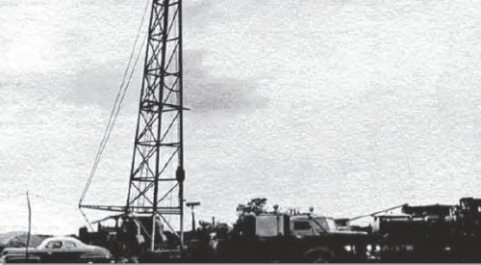
The first commercial hydraulic fracturing job (above) took place in 1949 about 12 miles east of Duncan, Oklahoma. Photo courtesy Halliburton.
“Since that fateful day in 1949, hydraulic fracturing has done more to increase recoverable reserves than any other technique,” proclaimed a Halliburton company spokesman in 2009, adding that more than two million fracturing treatments have been pumped without polluting an aquifer.
Erle P. Halliburton patented an efficient well-cementing technology in 1921 that improved oil production while protecting the environment. The earliest attempts to increase petroleum production by fracturing geologic formations began in the 1860s.
Learn more in Shooters – A ‘Fracking’ History.

March 17, 1949 – “Diamond Glenn” opens Shamrock Hotel
Texas independent producer “Diamond Glenn” McCarthy hosted the grand opening of his $21 million, 18-story, 1,100-room Shamrock Hotel on the outskirts of Houston. McCarthy reportedly spent another $1 million for the hotel’s St. Patrick’s Day opening day gala, including arranging for a 16-car Santa Fe Super Chief train to bring friends from Hollywood.
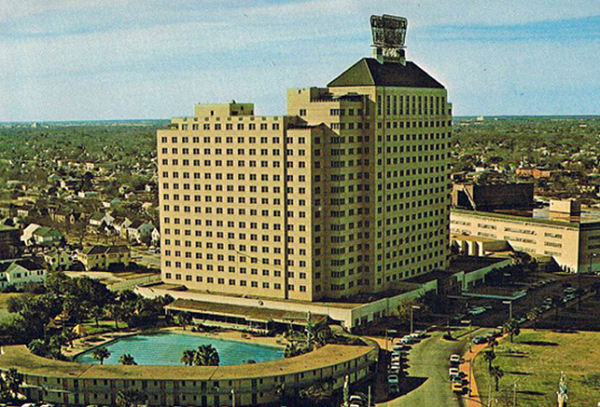
After paying $21 million to construct the Shamrock Hotel, Glenn McCarthy spent another $1 million for its grand opening on St. Patrick’s Day 1949. The 1,100-room Houston hotel was demolished in 1987.
The Texas wildcatter, who had discovered 11 oilfields by 1945, also introduced his own label of bourbon at Shamrock, the largest hotel in the United States at the time. Dubbed Houston’s biggest party, the Shamrock’s debut “made the city of Houston a star overnight,” one newspaper reported.
Learn more in “Diamond Glenn” McCarthy.
March 18, 1937 – New London School Explosion Tragedy
With just minutes left in the school day, a natural gas explosion destroyed the New London High School in Rusk County, Texas. Odorless gas (a residual natural gas called casing-head gas) had leaked into the basement and ignited with an explosion heard four miles away. East Texas oilfield workers — many with children attending the school — rushed to the scene, as did a cub reporter from Dallas, Walter Cronkite.

Roughnecks from the East Texas oilfield rushed to the devastated school and searched for survivors throughout the night. Photo courtesy New London Museum.
Despite desperate rescue efforts, 298 people were killed that day (dozens more later died of injuries). The explosion’s source was later found to be an electric wood-shop sander that sparked odorless gas that had pooled beneath and in the walls of the school. As a result of this disaster, Texas and other states passed laws requiring that natural gas be mixed with a malodorant to give early warning of a gas leak.
Learn more about the tragedy in New London School Explosion.
March 18, 1938 — First Offshore Well drilled off Louisiana
Oil production from a well drilled by Pure Oil and Superior Oil companies helped launch the modern offshore industry. The Creole oilfield in Louisiana’s offshore Cameron Parish was the first discovered in the open waters of the Gulf of Mexico, according to the Louisiana Department of Natural Resources (DNR). “A look back at both the Creole platform and others that followed after World War II provides a glimpse of history in the making,” noted Offshore magazine in 2014.
More offshore wells followed, including the Kerr-McGee drilling platform, Kermac Rig No. 16, which in 1947 became the first offshore rig out of sight of land. By the end of 1949, offshore exploration had discovered 11 oil and natural gas fields.
Learn more in Offshore Oil History.

March 20, 1919 – American Petroleum Institute founded
Tracing its roots to World War I when the petroleum industry and Congress worked together to fuel the war effort, the American Petroleum Institute (API) was founded in New York City. Within two years, the organization had improved an 1876 French scale to measure petroleum density relative to water — a standard later adopted and called API gravity. Based in Washington, D.C. since 1969, API has lobbied on behalf of major oil and natural gas companies while maintaining standards and recommended industry practices.
March 20, 1973 – Pennsylvania Boom Town recognized as Historic
The once-famous oil boom town of Pithole, Pennsylvania, was listed in the National Register of Historic Places. An 1865 oilfield discovery at Pithole Creek launched a drilling boom for the early U.S. petroleum industry, which had begun six years earlier in nearby Titusville. The Pithole field’s production would lead to construction of the nation’s first oil pipeline, but the boom ended after about 500 days.
Learn more in Oil Boom at Pithole Creek.
March 21, 1881 – Earth Scientist becomes USGS Director
President James Garfield appointed John Wesley Powell director of the United States Geological Survey (USGS), a scientific agency established two years earlier. Powell, who led USGS for the next decade, laid the foundation for modern earth science research.
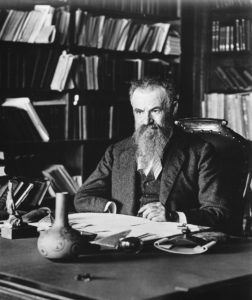
John Wesley Powell at his desk in Washington, D.C., in 1896. Photo courtesy Smithsonian Institution.
Born in 1834 at Mount Morris, New York, Powell was a Union officer during the Civil War, where he lost an arm at the Battle of Shiloh. After the war, he became a respected geologist and expedition leader, organized early surveys in the West, and helped establish USGS in 1879.
Powell advocated the national mapping standards and geodetic system still in use today. In 1884, Powell testified to Congress, “A Government cannot do any scientific work of more value to the people at large than by causing the construction of proper topographic maps of the country.”

March 23, 1858 – First U.S. Oil Exploration Company reorganizes
Investors from New Haven, Connecticut, organized the Seneca Oil Company with $300,000 in capital after purchasing the Titusville leases of the Pennsylvania Rock Oil Company, which had been founded in 1854 by George Bissell.
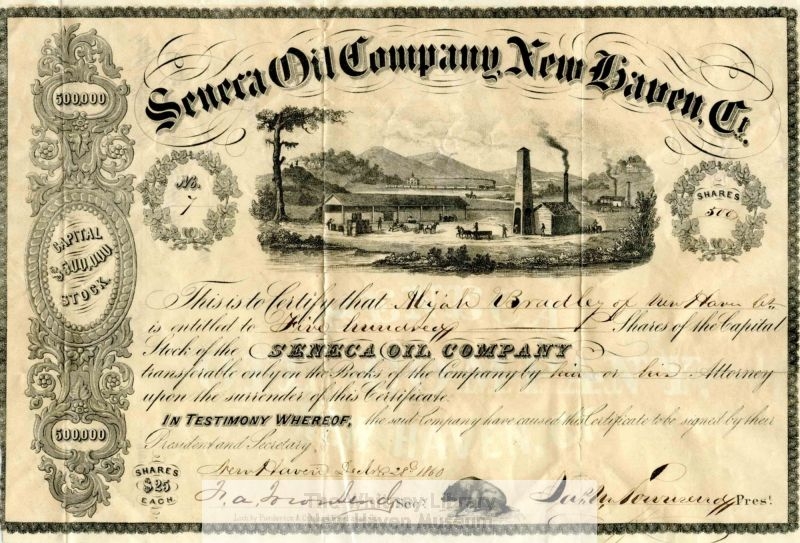
Seneca Oil drilled the first U.S. well. Image courtesy New Haven Museum.
Bissell, who had investigated oil seeps south of Titusville, originated the idea of producing and refining oil to make kerosene lamp fuel. The New Haven investors nevertheless excluded him from the oil exploration company.
Learn more in George Bissell’s Oil Seeps.
_______________________
Recommended Reading: Trek of the Oil Finders: A History of Exploration for Petroleum (1975); A History of the Greater Seminole Oil Field (1981); The Frackers: The Outrageous Inside Story of the New Billionaire Wildcatters
(1981); The Frackers: The Outrageous Inside Story of the New Billionaire Wildcatters  (2014).; The Green and the Black: The Complete Story of the Shale Revolution, the Fight over Fracking, and the Future of Energy
(2014).; The Green and the Black: The Complete Story of the Shale Revolution, the Fight over Fracking, and the Future of Energy (2016); Corduroy Road: The story of Glenn H. McCarthy (1951); A Texas Tragedy: The New London School Explosion
(2016); Corduroy Road: The story of Glenn H. McCarthy (1951); A Texas Tragedy: The New London School Explosion (2012); Offshore Pioneers: Brown & Root and the History of Offshore Oil and Gas
(2012); Offshore Pioneers: Brown & Root and the History of Offshore Oil and Gas (2011); Cherry Run Valley: Plumer, Pithole, and Oil City, Pennsylvania, Images of America
(2011); Cherry Run Valley: Plumer, Pithole, and Oil City, Pennsylvania, Images of America (2000); The Powell Expedition: New Discoveries about John Wesley Powell’s 1869 River Journey
(2000); The Powell Expedition: New Discoveries about John Wesley Powell’s 1869 River Journey (2017); Myth, Legend, Reality: Edwin Laurentine Drake and the Early Oil Industry
(2017); Myth, Legend, Reality: Edwin Laurentine Drake and the Early Oil Industry (2009). Your Amazon purchase benefits the American Oil & Gas Historical Society. As an Amazon Associate, AOGHS earns a commission from qualifying purchases.
(2009). Your Amazon purchase benefits the American Oil & Gas Historical Society. As an Amazon Associate, AOGHS earns a commission from qualifying purchases.
_______________________
The American Oil & Gas Historical Society (AOGHS) preserves U.S. petroleum history. Please become an AOGHS supporter and help maintain this energy education website and expand historical research. For more information, contact bawells@aoghs.org. Copyright © 2025 Bruce A. Wells. All rights reserved.

































